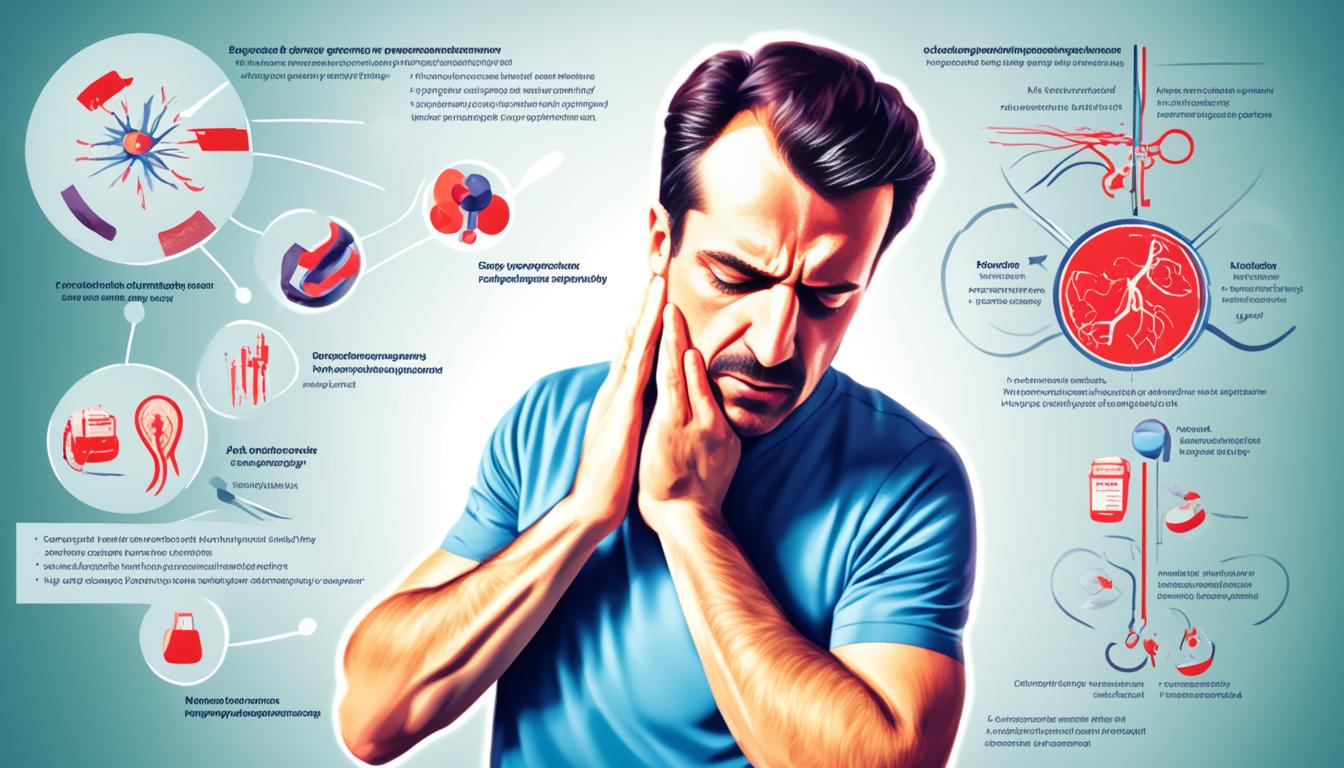High blood pressure, also called hypertension, is a dangerous heart and blood disease. It’s known as a “silent killer” because often, there are no symptoms. In Thailand, about 1 in 5 adults have high blood pressure. Over 40% of them have hypertension.
This condition happens when blood pushes too hard against artery walls. This can cause serious health issues like stroke, heart failure, or heart disease. There are two main types: essential hypertension, where the cause is unknown, and secondary hypertension, which is a symptom of another condition.
Rare conditions, kidney and thyroid diseases, tumors, and some drugs can cause secondary hypertension. Getting the right diagnosis and treatment is key in handling high blood pressure.
Key Takeaways:
- High blood pressure can silently harm the heart and blood vessels without clear signs.
- About 1 in 5 adults in Thailand faces this issue, while over 40% have hypertension.
- Secondary hypertension signals an underlying health problem.
- Issues like kidney disease, thyroid disease, or certain drugs may cause it.
- Getting the right diagnosis and treatment is crucial for managing high blood pressure.
Symptoms and Diagnosis of Secondary Hypertension
Secondary hypertension often shows mild symptoms, making them easy to miss. It’s possible not to see it until it gets serious. A few might have headaches, feel short of breath, or get nosebleeds. But, most people with high blood pressure won’t feel or show any signs.
It’s key to check your blood pressure often, and get regular health check-ups. This helps catch secondary hypertension early. There are guidelines to tell if your blood pressure is too high and, if it is, how much risk you’re at. The European Society of Cardiology updates guidelines for diagnosing and dealing with high blood pressure.
Think about the risks of secondary hypertension, like heart problems and organ damage. Finding and managing it early can lower these risks and make you healthier.
Symptoms of Secondary Hypertension
How secondary hypertension shows itself can change based on the cause. Besides the previous signs, others might be:
- Flushing
- Swelling
- Changes in vision
- Fatigue
- Irritability
- Confusion
These signs aren’t only for secondary hypertension. They might signal other issues too. So, seeing a healthcare expert is key to know the truth.
Diagnosis of Secondary Hypertension
To diagnose secondary hypertension, the doctor looks at your health history and does physical checks. This includes tests to look at risks like kidney disease or overactive thyroid.
Tests used may be:
- Blood tests: To check kidney and thyroid health
- Urine tests: For protein or blood and to spot kidney issues
- Ultrasound: To see kidney and adrenal gland health
- MRI or CT scan: To look for problems in kidneys, adrenal glands, or other parts
- Hormone tests: To find any issues in hormone levels
Getting the right diagnosis is crucial for the best treatment plan. Once the cause is known, the doctor can suggest how to treat it to stay healthy and avoid problems.
References:
| Reference | Description |
|---|---|
| 1 | Graham I, et al. European Guidelines on Cardiovascular Disease Prevention in Clinical Practice: Full Text. Fourth Joint Task Force of the European Society of Cardiology and other societies on cardiovascular disease prevention in clinical practice (constituted by representatives of nine societies and by invited experts). Eur J Cardiovasc Prev Rehabil. 2007;14 Suppl 2:S1-113. |
| 2 | Park SH, et al. Guidelines for diagnosing and managing hypertension in Korea: A scientific statement from the Korean Society of Hypertension. Clin Hypertens. 2015;21:1-13. |
Causes and Risk Factors of Secondary Hypertension
Secondary hypertension is high blood pressure due to another health issue. It is linked to different medical problems and how we live. Knowing these causes is key to dealing with this condition.
Underlying Medical Conditions
Problems like kidney disease, thyroid issues, or adrenal tumors can cause secondary hypertension. They affect how our bodies work, pushing blood pressure up.
Medications and Substances
Some medicines can make secondary hypertension worse. Birth control, cold meds, and certain asthma drugs are on the list. So are substances like cocaine, too much alcohol, and smoking.
Risk Factors
Some things make it more likely you’ll have secondary hypertension. For instance, age and a family history of heart problems are big factors. Also, being very overweight, not moving enough, eating lots of salt, and not eating well can cause it.
- Alcohol abuse and smoking both make hypertension worse.
- Too much stress and anxiety also play a part.
To fight secondary hypertension, work on these risks. Start with a healthy diet, regular exercise, and staying at a good weight. Stop smoking and don’t drink too much. This can help prevent the problem from happening or getting worse.
Stem Cell Therapy for Secondary Hypertension
Stem cell therapy shows huge potential in treating secondary hypertension. Studies using adult bone marrow stem cells called MSCs in animals have exciting results. These cells have improved the function of the right ventricle and lessened lung issues in models with pulmonary hypertension.
Moreover, allogenic stem cell therapy significantly improved the right ventricle’s job and reduced the changes in the pulmonary artery. Also, using EPCs seems promising in easing pulmonary hypertension. This happens by encouraging new blood vessel growth and making the lungs better.
These discoveries shed light on how stem cell therapy could be a groundbreaking treatment for secondary hypertension. Yet, we need more studies and trials to check how safe and effective it is for human patients. With ongoing research, we might discover new ways to treat this condition, offering better chances for those living with it.

